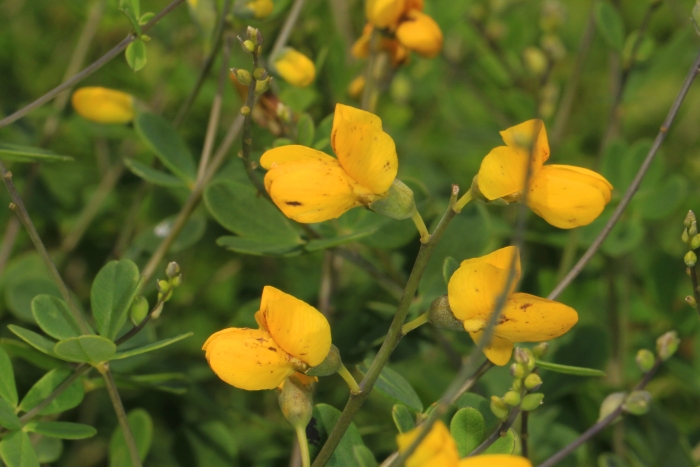Yellow Wild Indigo
(Baptisia sphaerocarpa)
Yellow Wild Indigo (Baptisia sphaerocarpa)
/
/

© Judy Gallagher
CC BY-SA 4.0
Image By:
© Judy Gallagher
Recorded By:
Copyright:
CC BY-SA 4.0
Copyright Notice:
Photo by: © Judy Gallagher | License Type: CC BY-SA 4.0 | License URL: http://creativecommons.org/licenses/by-sa/4.0/ | Uploader: judygva | Publisher: iNaturalist |

























Estimated Native Range
Summary
Baptisia sphaerocarpa, commonly known as Yellow Wild Indigo, is a deciduous perennial herb native to the open woodlands, prairies, and glades of the South Central United States. This plant typically grows to a height and width of 2-3 feet (0.6-0.9 meters), forming an upright, bushy mound of clover-like foliage. The bright yellow, pea-like flowers bloom in dense spikes atop the foliage in late spring to early summer, creating a showy display that can last several weeks. After flowering, ornamental, inflated seed pods may add additional interest in the landscape.
Yellow Wild Indigo is valued for its drought tolerance, low maintenance requirements, and ability to thrive in poor soils. It is often used in naturalized plantings, prairie restorations, and as an accent in perennial borders. It is also a host plant for certain butterfly species, adding to its ecological value. In cultivation, it prefers full sun to part shade and well-drained soils, though it is adaptable to various conditions once established. Overwatering or poorly drained soils can lead to root rot. It is generally pest and disease resistant, but can occasionally suffer from foliar diseases in humid conditions.CC BY-SA 4.0
Yellow Wild Indigo is valued for its drought tolerance, low maintenance requirements, and ability to thrive in poor soils. It is often used in naturalized plantings, prairie restorations, and as an accent in perennial borders. It is also a host plant for certain butterfly species, adding to its ecological value. In cultivation, it prefers full sun to part shade and well-drained soils, though it is adaptable to various conditions once established. Overwatering or poorly drained soils can lead to root rot. It is generally pest and disease resistant, but can occasionally suffer from foliar diseases in humid conditions.CC BY-SA 4.0
Plant Description
- Plant Type: Herb
- Height: 2-3 feet
- Width: 2-3 feet
- Growth Rate: Moderate
- Flower Color: Yellow
- Flowering Season: Spring, Summer
- Leaf Retention: Deciduous
Growth Requirements
- Sun: Full Sun, Part Shade
- Water: Medium
- Drainage: Fast
Common Uses
Bee Garden, Bird Garden, Butterfly Garden, Deer Resistant, Drought Tolerant, Erosion Control, Groundcover, Low Maintenance, Rabbit Resistant, Rock Garden, Showy Flowers
Natural Habitat
Open woodlands, prairies, and glades of the South Central United States
Other Names
Common Names: Green Wild Indigo, Round Wild Indigo
Scientific Names: , Baptisia sphaerocarpa, Baptisia viridis,
GBIF Accepted Name: Baptisia sphaerocarpa Nutt.